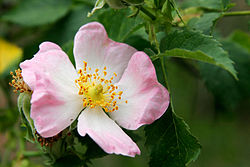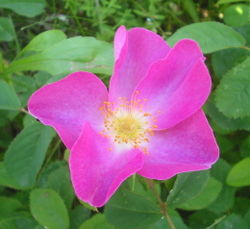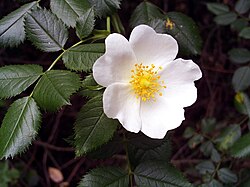Subgenera and sections


There are currently four subgenera in Rosa, although there have been some disputes over the years. [3] The four subgenera are:
- Hulthemia (formerly Simplicifoliae, meaning "with single leaves") containing one or two species from Southwest Asia, R. persica and R. berberifolia (syn. R. persica var. berberifolia) which are the only species without compound leaves or stipules.
- Hesperrhodos (from the Greek for "western rose") with two species, both from southwestern North America, R. minutifolia and R. stellata.
- Platyrhodon (from the Greek for "flaky rose", referring to its flaky bark) with one species from East Asia, R. roxburghii.
- Rosa (the type subgenus) containing all the other species. This subgenus is subdivided into 11 sections.
- Banksianae – white and yellow species from China
- Bracteatae – three species, two from China and one from India
- Caninae – pink and white species from Europe, Asia and North Africa
- Carolinae – white, pink and bright pink species, all from North America
- Chinensis – white, pink, yellow, red and mixed-color species from China and Burma
- Gallicanae – pink to crimson and striped species from Europe and West Asia
- Gymnocarpae – a small group distinguished by a deciduous receptacle on the hip; one species in western North America (R. gymnocarpa), the rest in East Asia
- Laevigatae – a single white species from China
- Pimpinellifoliae – white, pink, bright yellow, mauve and striped species from Europe and Asia
- Rosa (syn. sect. Cinnamomeae) – white, pink, lilac, mulberry and red species from all areas except North Africa
- Synstylae – white, pink, and crimson species from all areas
















